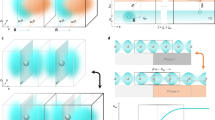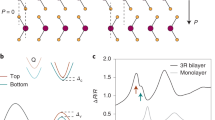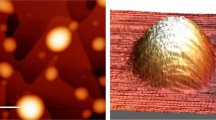Abstract
Given its innate coupling with wavefunction geometry in solids and its potential to boost the solar energy conversion efficiency, the bulk photovoltaic effect (BPVE) has been of considerable interest in the past decade1,2,3,4,5,6,7,8,9,10,11,12,13,14. Initially discovered and developed in ferroelectric oxide materials2, the BPVE has now been explored in a wide range of emerging materials, such as Weyl semimetals9,10, van der Waals nanomaterials11,12,14, oxide superlattices15, halide perovskites16, organics17, bulk Rashba semiconductors18 and others. However, a feasible experimental approach to optimize the photovoltaic performance is lacking. Here we show that strain-induced polarization can significantly enhance the BPVE in non-centrosymmetric rhombohedral-type MoS2 multilayer flakes (that is, 3R-MoS2). This polarization-enhanced BPVE, termed the piezophotovoltaic effect, exhibits distinctive crystallographic orientation dependence, in that the enhancement mainly manifests in the armchair direction of the 3R-MoS2 lattice while remaining largely intact in the zigzag direction. Moreover, the photocurrent increases by over two orders of magnitude when an in-plane tensile strain of ~0.2% is applied, rivalling that of state-of-the-art materials. This work unravels the potential of strain engineering in boosting the photovoltaic performance, which could potentially promote the exploration of novel photoelectric processes in strained two-dimensional layered materials and their van der Waals heterostructures.
This is a preview of subscription content, access via your institution
Access options
Access Nature and 54 other Nature Portfolio journals
Get Nature+, our best-value online-access subscription
$29.99 / 30 days
cancel any time
Subscribe to this journal
Receive 12 print issues and online access
$259.00 per year
only $21.58 per issue
Buy this article
- Purchase on Springer Link
- Instant access to full article PDF
Prices may be subject to local taxes which are calculated during checkout




Similar content being viewed by others
Data availability
The data that support the findings of this study are presented in the Letter and Supplementary Information, and are available from the corresponding authors upon reasonable request. Source data are provided with this paper.
References
Sturman, B. I. & Fridkin, V. M. The Photovoltaic and Photorefractive Effects in Noncentrosymmetric Materials (Routledge, 1992).
Glass, A. M., Linde, D. V. D. & Negran, T. J. High-voltage bulk photovoltaic effect and the photorefractive process in LiNbO3. Appl. Phys. Lett. 25, 233 (1974).
Bhatnagar, A., Chaudhuri, A. R., Kim, Y. H., Hesse, D. & Alexe, M. Role of domain walls in the abnormal photovoltaic effect in BiFeO3. Nat. Commun. 4, 2835 (2013).
Morimoto, T. & Nagaosa, N. Topological nature of nonlinear optical effects in solids. Sci. Adv. 2, e1501524 (2016).
Morimoto, T. & Nagaosa, N. Topological aspects of nonlinear excitonic processes in noncentrosymmetric crystals. Phys. Rev. B 94, 035117 (2016).
Sotome, M. et al. Terahertz emission spectroscopy of ultrafast exciton shift current in the noncentrosymmetric semiconductor CdS. Phys. Rev. B 103, L241111 (2021).
Spanier, J. E. et al. Power conversion efficiency exceeding the Shockley–Queisser limit in a ferroelectric insulator. Nat. Photonics 10, 611–616 (2016).
Yang, M.-M., Kim, D. J. & Alexe, M. Flexo-photovoltaic effect. Science 360, 904–907 (2018).
Ma, J. et al. Nonlinear photoresponse of type-II Weyl semimetals. Nat. Mater. 18, 476–481 (2019).
Osterhoudt, G. B. et al. Colossal mid-infrared bulk photovoltaic effect in a type-I Weyl semimetal. Nat. Mater. 18, 471–475 (2019).
Zhang, Y. et al. Enhanced intrinsic photovoltaic effect in tungsten disulfide nanotubes. Nature 570, 349–353 (2019).
Akamatsu, T. et al. A van der Waals interface that creates in-plane polarization and a spontaneous photovoltaic effect. Science 372, 68–72 (2021).
Jiang, J. et al. Flexo-photovoltaic effect in MoS2. Nat. Nanotechnol. 16, 894–901 (2021).
Li, Y. et al. Enhanced bulk photovoltaic effect in two-dimensional ferroelectric CuInP2S6. Nat. Commun. 12, 5896 (2021).
Yun, Y., Mühlenbein, L., Knoche, D. S., Lotnyk, A. & Bhatnagar, A. Strongly enhanced and tunable photovoltaic effect in ferroelectric-paraelectric superlattices. Sci. Adv. 7, eabe4206 (2021).
Tan, L. Z. et al. Shift current bulk photovoltaic effect in polar materials—hybrid and oxide perovskites and beyond. npj Comput. Mater. 2, 16026 (2016).
Nakamura, M. et al. Shift current photovoltaic effect in a ferroelectric charge-transfer complex. Nat. Commun. 8, 281 (2017).
Ogawa, N., Bahramy, M. S., Kaneko, Y. & Tokura, Y. Photocontrol of Dirac electrons in a bulk Rashba semiconductor. Phys. Rev. B 90, 125122 (2014).
Nadupalli, S., Kreisel, J. & Granzow, T. Increasing bulk photovoltaic current by strain tuning. Sci. Adv. 5, eaau9199 (2019).
Schankler, A. M., Guo, L. & Rappe, A. M. J. Large bulk piezophotovoltaic effect of monolayer 2H-MoS2. Phys. Chem. Lett. 12, 1244–1249 (2021).
Bertolazzi, S., Brivio, J. & Kis, A. Stretching and breaking of ultrathin MoS2. ACS Nano 5, 9703–9709 (2011).
Lee, J., Wang, Z., Xie, H., Mak, K. F. & Shan, J. Valley magnetoelectricity in single-layer MoS2. Nat. Mater. 16, 887–891 (2017).
Zhao, M. et al. Atomically phase-matched second-harmonic generation in a 2D crystal. Light Sci. Appl. 5, e16131 (2016).
Suzuki, R. et al. Valley-dependent spin polarization in bulk MoS2 with broken inversion symmetry. Nat. Nanotechnol. 9, 611–617 (2014).
Anghel, S. et al. Identification of 2H and 3R polytypes of MoS2 layered crystals using photoluminescence spectroscopy. Preprint at arXiv https://arxiv.org/abs/1411.3850 (2014).
Rice, C., Young, J., Zan, R. & Bangert, U. Raman-scattering measurements and first-principles calculations of strain-induced phonon shifts in monolayer MoS2. Phys., Rev. B 87, 081307 (2013).
Nye, J. F. Physical Properties of Crystals: Their Representation by Tensors and Matrices (Oxford Univ. Press, 1985).
Mennel, L. et al. Optical imaging of strain in two-dimensional crystals. Nat. Commun. 9, 516 (2018).
Gabor, N. M. et al. Hot carrier-assisted intrinsic photoresponse in graphene. Science 334, 648–652 (2011).
Dai, Z., Schankler, A. M., Gao, L., Tan, L. Z. & Rappe, A. M. Phonon-assisted ballistic current from first-principles calculations. Phys. Rev. Lett. 126, 177403 (2021).
Sturman, B. I. Ballistic and shift currents in the bulk photovoltaic effect theory. Phys. Usp. 63, 407–411 (2020).
Matsuo, H., Noguchi, Y. & Miyayama, M. Gap-state engineering of visible-light-active ferroelectrics for photovoltaic applications. Nat. Commun. 8, 207 (2017).
Novoselov, K. S. et al. Two-dimensional atomic crystals. Proc. Natl Acad. Sci. USA 102, 10451–10453 (2005).
Castellanos-Gomez, A. et al. Deterministic transfer of two-dimensional materials by all-dry viscoelastic stamping. 2D Mater. 1, 011002 (2004).
Guo, Y. et al. Distinctive in-plane cleavage behaviors of two-dimensional layered materials. ACS Nano 10, 8980–8988 (2016).
Acknowledgements
We thank M. Ishida for support with the schematic diagram preparation. Y.D. was supported by the World-leading Innovative Graduate Study Program for Materials Research, Information, and Technology (MERIT-WINGS) and JSPS KAKENHI grant number JP22J22007. M.-M.Y. acknowledges the Special Postdoctoral Researchers Program from RIKEN and financial support from JSPS KAKENHI grant number JP21K14542. T.I. was supported by JSPS KAKENHI grant number JP19H01819. T.I. and T.M. were supported by JST PRESTO (JPMJPR19L1 and JPMJPR19L9). This work was supported by JSPS KAKENHI grant number JP19H05602 and the A3 Foresight Program.
Author information
Authors and Affiliations
Contributions
M.-M.Y. and Y.I. conceived the idea and designed the experiments. Under the supervision of Y.I. and T.I., Y.D. prepared the devices and measured the experimental data. M.-M.Y. set up the photocurrent-mapping system. M.Y., S.K. and T.M. performed the theoretical calculations. N.O. supported the SHG measurements. S.M. and T.H. supported the absorption spectrum measurements. All the authors discussed the results. Y.D., M.-M.Y., T.I. and Y.I. wrote the manuscript.
Corresponding author
Ethics declarations
Competing interests
The authors declare no competing interests.
Peer review
Peer review information
Nature Nanotechnology thanks Goki Eda and the other, anonymous, reviewer(s) for their contribution to the peer review of this work.
Additional information
Publisher’s note Springer Nature remains neutral with regard to jurisdictional claims in published maps and institutional affiliations.
Extended data
Extended Data Fig. 1 Strain distribution of the strained 3R-MoS2 device.
a, The optical photo of a strained 3R-MoS2 device which is same to that used in Fig. 3b of the main text. The red dashed circle indicates where SHG is measured. Several Raman spectra are taken at different postions indicated by the dots. b, The Raman spectrum taken at different positions in the channel. The black dashed line indicates the unstrained peak position. c, A distortred SHG polarization dependence pattern taken from the electrode region. The angle here refers to that between laser polaization and armchair direction of the flake.
Extended Data Fig. 2 Photocurrent mapping and laser power dependence of photocurrent in an unstrained 3R-MoS2 device.
a, The optical photo of an unstrained 3R-MoS2 device. The red dot indicates the position where laser power dependence is measured. b, The laser power dependence in unstrained 3R-MoS2 device. c, the photocurrent spatial mapping of the unstrained 3R-MoS2. The solid and dashed black lines indicate the electrode edges and the flake edges, respectively. The green dashed line marks where the line profile is taken. d, The line profile of the unstrained 3R-MoS2 device photocurrent mapping. The yellow region is the electrode region.
Extended Data Fig. 3 Characterization of intrinsic BPVE in pristine 3R-MoS2 device.
a, Cross-bar shaped pristine 3R-MoS2 device. The thickness of the flake is about 2 nm. b, Spatial distribution of photocurrent along the armchair direction mapped in the area marked by white dash frame in a. The black lines indicate the electrode edge and the black dash lines illustrate the edges of the 3R-MoS2 flake. c, The light polarization dependence of the photocurrent along the armchair direction under illumination of 100 μW. The illuminated position is at the centre of device marked by red circle. Black line is the fit by the BPVE phenomenology theory. The offset may come from the electrode contact-related contribution.
Extended Data Fig. 4 Photoresponse of 2H-MoS2 flake strained along zigzag direction.
a, Schematic diagram of 2H-MoS2 lattice with strain applied along the zigzag direction. b, The optical image of strained 2H-MoS2 device. The blue arrow indicates zigzag direction of the flake. c, The photocurrent mapping result of strained 2H-MoS2 along zigzag. The solid and dashed black lines indicate the electrode edges and the flake edges, respectively.
Extended Data Fig. 5 Reproducibility of the piezophotovoltaic effect in strained 3R-MoS2 devices.
Device images and photocurrent distribution of a-c, device 1; d-f, device 2 and g-i, device 3. The solid and dashed black lines indicate the electrode edges and the flake edges, respectively. The green dashed line in the mapping plots (the middle row) marks where the line profile is taken. c, f, i are the line profile analysis extracted from position marked by green lines in the photocurrent mapping images.
Extended Data Fig. 6 Piezophotovoltaic effect of 3R-MoS2 device in two different strain states.
Device images and photoresponse of a, c, e 0.1% strained and b, d, f, 0.15% strained 3R-MoS2 device. c and d are the spatial distribution of the photocurrent under two different strain states. The line profile analysis shown in e, f are acquired from locations marked by green line in c, d, respectively. The laser power used here is 7 μW.
Extended Data Fig. 7 Laser polarization dependence of photocurrent at different strain states.
The polarization dependence results from three devices with strain-free, 0.1 and 0.16% of strain states. The 0.1%, 0.16% strained samples are measured by 630 nm laser with a power of 2.85 μW. The strain-free sample is measured by 633 nm laser with a power of 100 μW.
Extended Data Fig. 8 Photocurrent mapping at different light wavelengths in a strained 3R-MoS2 device.
a, The optical photo of the strained 3R-MoS2 device. The white dashed line indicates where the mappings are taken. b, The averaged photocurrent values acquired from the mapping results at each photon energy. The averaged region is indicated by the black dashed line in c. c-g, the photocurrent mapping taken at different photon energy. The laser power used in all the wavelengths is about 3 μW.
Extended Data Fig. 9 Laser polarization dependence at different light wavelengths in strained 3R-MoS2 device.
The polarization dependence taken at a, 2.47 eV; b, 2.25 eV and c, 1.83 eV from a single strained 3R-MoS2 device. The laser power for all the wavelengths is about 3 μW.
Extended Data Fig. 10 Spectrum of absorption, photoconductivity and photoresponse in 3R-MoS2.
The absorption spectrum of 3R-MoS2, and the peak positions are 1.86 eV, 2.04 eV and 2.7 eV respectively. The photoconductivity spectrum of strained 3R-MoS2 (it is calculated from (σbright − σdark)/P, unit is mS/W), and the peak positions are also around 1.86 eV, 2.04 eV and 2.7 eV. All the curves are renormalized, and the offset is included for the sake of clarity.
Supplementary information
Supplementary Information
Supplementary Figs. 1–3 and discussion of the theory.
Source data
Source Data Fig. 1
Source data for the plot.
Source Data Fig. 2
Source data for the plot.
Source Data Fig. 3
Source data for the plot.
Source Data Fig. 4
Source data for the plot.
Rights and permissions
Springer Nature or its licensor (e.g. a society or other partner) holds exclusive rights to this article under a publishing agreement with the author(s) or other rightsholder(s); author self-archiving of the accepted manuscript version of this article is solely governed by the terms of such publishing agreement and applicable law.
About this article
Cite this article
Dong, Y., Yang, MM., Yoshii, M. et al. Giant bulk piezophotovoltaic effect in 3R-MoS2. Nat. Nanotechnol. 18, 36–41 (2023). https://doi.org/10.1038/s41565-022-01252-8
Received:
Accepted:
Published:
Issue Date:
DOI: https://doi.org/10.1038/s41565-022-01252-8
This article is cited by
-
Giant intrinsic photovoltaic effect in one-dimensional van der Waals grain boundaries
Nature Communications (2024)
-
Non-volatile electrical polarization switching via domain wall release in 3R-MoS2 bilayer
Nature Communications (2024)
-
Superconducting tunnel junctions with layered superconductors
Quantum Frontiers (2024)
-
Stress testing the bulk photovoltaic effect
Nature Nanotechnology (2023)
-
Strong bulk photovoltaic effect in engineered edge-embedded van der Waals structures
Nature Communications (2023)



